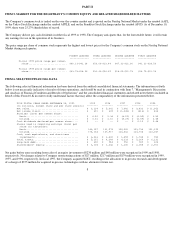Apple 1999 Annual Report Download - page 21
Download and view the complete annual report
Please find page 21 of the 1999 Apple annual report below. You can navigate through the pages in the report by either clicking on the pages listed below, or by using the keyword search tool below to find specific information within the annual report.obtained at favorable rates. The inability to obtain such borrowings at favorable rates could materially adversely affect the Company's results of
operations, financial condition, and liquidity.
OTHER LONG-TERM INVESTMENTS
As discussed above, the Company has categorized its shares in ARM as available-for-sale requiring the shares be carried at fair value, with
unrealized gains and losses net of taxes reported as a component of accumulated other comprehensive income. As of September 25, 1999, the
Company held 16 million shares of ARM stock valued at $226 million. During the first quarter of fiscal 2000 through December 17, 1999, the
Company sold an additional 5.1 million shares of ARM stock for net proceeds of approximately $136 million and gains before taxes of
approximately $134 million. As of December 17, 1999, the Company holds 10.9 million shares of ARM stock valued at approximately $690
million.
During the fourth quarter of 1999, the Company invested $100 million in Samsung Electronics Co., Ltd (Samsung) to assist in the further
expansion of Samsung's TFT-LCD flat-panel display production capacity. The investment, in the form of three year unsecured bonds, is
convertible into approximately 550,000 shares of Samsung common stock beginning in June 2000. The bonds carry an annual coupon rate of
2% and pay a total yield to maturity of 5% if redeemed at their maturity.
In June 1999, the Company invested $12.5 million in Akamai Technologies, Inc. (Akamai), a global Internet content delivery service. The
investment was in the form of convertible preferred stock that converted into 4.1 million shares of Akamai common stock (adjusted for
subsequent stock splits) at the time of Akamai's initial public offering in October 1999. The Company is restricted from selling more than 25%
of its shares within one year after the date of the closing of a public offering of Akamai's stock. Beginning in the first quarter of fiscal 2000, the
Company has categorized its shares in Akamai as available-for-sale requiring they be carried at fair value with unrealized gains and losses net
of taxes reported as a component of accumulated other comprehensive income. As of December 17, 1999, the fair value of the Company's
investment in Akamai was approximately $1.2 billion. Because Akamai is a newly public company and its stock price has experienced
significant volatility, the fair value of the Company's investment in Akamai may fluctuate significantly in the future.
YEAR 2000 COMPLIANCE
THE INFORMATION PRESENTED BELOW RELATED TO YEAR 2000 (Y2K) COMPLIANCE CONTAINS FORWARD-LOOKING
STATEMENTS THAT ARE SUBJECT TO RISKS AND UNCERTAINTIES. THE COMPANY'S ACTUAL RESULTS MAY DIFFER
SIGNIFICANTLY FROM THOSE DISCUSSED BELOW AND ELSEWHERE IN THIS FORM 10-K REGARDING Y2K COMPLIANCE.
YEAR 2000
The Year 2000 (Y2K) issue is the result of certain computer hardware, operating system software and software application programs having
been developed using two digits rather than four to define a year. For example, the clock circuit in the hardware may be incapable of holding a
date beyond the year 1999; some operating systems may recognize a date using "00" as the year 1900 rather than 2000 and certain applications
may have limited date processing capabilities. These problems could result in the failure of major systems or miscalculations, which could have
a material impact on companies through business interruption or shutdown, financial loss, damage to reputation, and legal liability to third
parties.
Y2K PLAN
The Company's Information Systems and Technology department (IS&T) began addressing the Y2K issue in 1996 as part of its Next
Generation strategy, which addressed the need for ongoing enhancement and replacement of the Company's various disparate legacy
information technology (IT) Systems. In 1998, the Company established a Year 2000 Executive Steering Committee (Steering Committee)
comprised of senior executives of the Company and the Company's Year 2000 Project Management Office (PMO). The PMO reports to the
Executive Vice President and Chief Financial Officer, the Steering Committee, and the Audit and Finance Committee of the Board of
Directors.
18
























